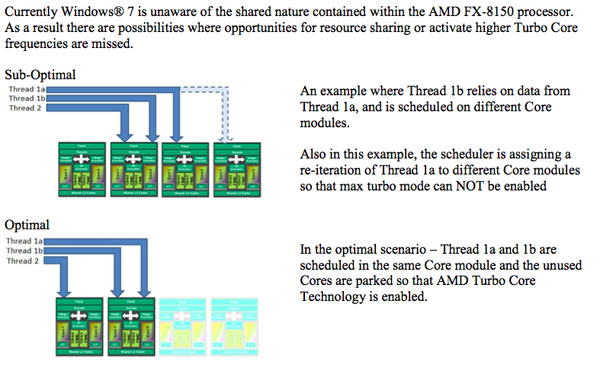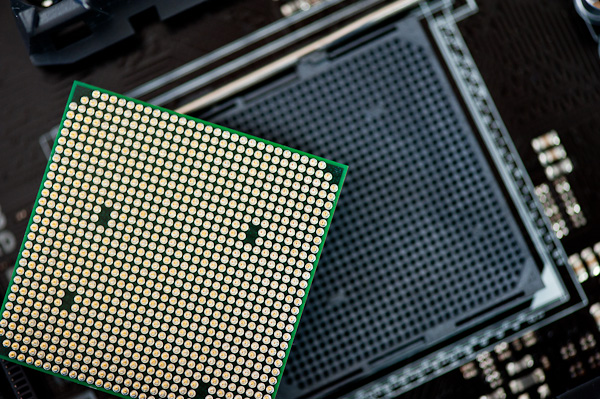The Bulldozer Review: AMD FX-8150 Tested
by Anand Lal Shimpi on October 12, 2011 1:27 AM ESTFinal Words
In many cases, AMD's FX-8150 is able to close the gap between the Phenom II X6 and Intel's Core i5 2500K. Given the right workload, Bulldozer is actually able to hang with Intel's fastest Sandy Bridge parts. We finally have a high-end AMD CPU with power gating as well as a very functional Turbo Core mode. Unfortunately the same complaints we've had about AMD's processors over the past few years still apply here today: in lightly threaded scenarios, Bulldozer simply does not perform. To make matters worse, in some heavily threaded applications the improvement over the previous generation Phenom II X6 simply isn't enough to justify an upgrade for existing AM3+ platform owners. AMD has released a part that is generally more competitive than its predecessor, but not consistently so. AMD also makes you choose between good single or good multithreaded performance, a tradeoff that we honestly shouldn't have to make in the era of power gating and turbo cores.
Bulldozer is an interesting architecture for sure, but I'm not sure it's quite ready for prime time. AMD clearly needed higher clocks to really make Bulldozer shine and for whatever reason it was unable to attain that. With Piledriver due out next year, boasting at least 10-15% performance gains at the core level it seems to me that AMD plans to aggressively address the shortcomings of this architecture. My only concern is whether or not a 15% improvement at the core level will be enough to close some of the gaps we've seen here today. Single threaded performance is my biggest concern, and compared to Sandy Bridge there's a good 40-50% advantage the i5 2500K enjoys over the FX-8150. My hope is that future derivatives of the FX processor (perhaps based on Piledriver) will boast much more aggressive Turbo Core frequencies, which would do wonders at eating into that advantage.

AMD also shared with us that Windows 7 isn't really all that optimized for Bulldozer. Given AMD's unique multi-core module architecture, the OS scheduler needs to know when to place threads on a single module (with shared caches) vs. on separate modules with dedicated caches. Windows 7's scheduler isn't aware of Bulldozer's architecture and as a result sort of places threads wherever it sees fit, regardless of optimal placement. Windows 8 is expected to correct this, however given the short lead time on Bulldozer reviews we weren't able to do much experimenting with Windows 8 performance on the platform. There's also the fact that Windows 8 isn't expected out until the end of next year, at which point we'll likely see an upgraded successor to Bulldozer.

So what do you do if you're buying today? If you have an existing high-end Phenom II system, particularly an X4 970 or above or an X6 of any sort, I honestly don't see much of a reason to upgrade. You're likely better off waiting for the next (and final) iteration of the AM3+ lineup if you want to stick with your current platform. If you're considering buying new, I feel like the 2500K is a better overall part. You get more predictable performance across the board regardless of application type or workload mix, and you do get features like Quick Sync. In many ways, where Bulldozer is a clear win is where AMD has always done well: heavily threaded applications. If you're predominantly running well threaded workloads, Bulldozer will typically give you performance somewhere around or above Intel's 2500K.
I was hoping for Bulldozer to address AMD's weakness rather than continue to just focus on its strengths. I suspect this architecture will do quite well in the server space, but for client computing we may have to wait a bit longer for a more competitive part from AMD. The true culprit for Bulldozer's lackluster single-threaded performance is difficult to track down. The easy answer would seem to be clock speed. We've heard of issues at Global Foundries and perhaps Bulldozer is the latest victim. If AMD's clock targets were 30% higher than Phenom II, it simply didn't make them with the FX-8150. I've heard future derivatives will focus more on increasing IPC indepedent of process technology and clock speed, but if you asked me what was the one limit to success I would say clock speed. As a secondary factor, AMD appeared to make some tradeoffs to maintain a reasonable die size at 32nm. Even then Bulldozer can hardly be considered svelte. I suspect as AMD is able to transition to smaller transistor geometries, it will be able to address some of Bulldozer's physical shortcomings.
The good news is AMD has a very aggressive roadmap ahead of itself; here's hoping it will be able to execute against it. We all need AMD to succeed. We've seen what happens without a strong AMD as a competitor. We get processors that are artificially limited and severe restrictions on overclocking, particularly at the value end of the segment. We're denied choice simply because there's no other alternative. I don't believe Bulldozer is a strong enough alternative to force Intel back into an ultra competitive mode, but we absolutely need it to be that. I have faith that AMD can pull it off, but there's still a lot of progress that needs to be made. AMD can't simply rely on its GPU architecture superiority to sell APUs; it needs to ramp on the x86 side as well—more specifically, AMD needs better single threaded performance. Bulldozer didn't deliver that, and I'm worried that Piledriver alone won't be enough. But if AMD can stick to a yearly cadence and execute well with each iteration, there's hope. It's no longer a question of whether AMD will return to the days of the Athlon 64, it simply must. Otherwise you can kiss choice goodbye.











430 Comments
View All Comments
B3an - Wednesday, October 12, 2011 - link
Yep this really is extremely disappointing. I'm actually going to call this AMD's Pentium 4. Thats how bad this is.2 billion transistors - thats a massive increase over the Phenom II X6 and what do we get? Nothing. The Phenom II is atleast as good with WAY less transistors and lower power consumption under load. I'm pretty shocked at how bad Bulldozer is. I wasn't expecting performance clock for clock to be as good as Nehalem, let alone Sandy Bridge, but this is just... appalling. When Ivy Bridge is out the performance difference is going to be MASSIVE.
Intel are surely going to implement more restrictions and hold there clocks speeds back even further. Theres just no competition anymore. Sad day for consumers.
bennyg - Wednesday, October 12, 2011 - link
AMD's Prescott to be exact... ironically that's one thing they seemed to shoot for in deepening pipeline and hoping that process would be better... hopefully this is just immature and soon there will be a GF110-style refresh that does it properly...Otherwise the whole next gen of AMD CPUs will continue to fight for scraps at the bottom of the heap... and their laptop CPUs will not even succeed there.
TekDemon - Wednesday, October 12, 2011 - link
I don't even know if it's just the process since those power consumption figures seem to suggest that they're being limited by the sheer amount of power it's using and the heat being generated from that. Intel had planned to take the P4 to 10Ghz but the fact that it was a power hog prevented that from realistically happening and it seems like you have the same issue here. The clockspeed potential is clearly there since it can hit 7Ghz under liquid nitrogen but for a normal air heatsink setup this is a recipe for failure. It's just way too power hungry and not fast enough to justify it. Why would anybody choose to use an extra 100 watts for largely the same or worse performance vs an i5 2500K?Thermalzeal - Wednesday, October 12, 2011 - link
I agree, 2 billion transistors are doing what exactly?The worst thing is that the water cooler isn't included with the FX-8150. At the performance levels they are providing, they should have just upped the price 30-50 bucks and provided the cooler gratis. Who's gonna need an AMD branded cooler if their not going to buy bulldozer?
The other point of these review is that there is no availability of any of the parts. So what a wonderful paper launch we have here. Seems like AMD isn't betting on anyone being interested enough to buy one of these things.
Blasphemy.
eanazag - Wednesday, October 12, 2011 - link
You can find them on Newegg today. The price is jacked up though. Newegg must not read AT.jleach1 - Friday, October 21, 2011 - link
Sigh...it's quite sad. There must be actual people buying these...either that or the supply is terrible. Because there's no way in hell i'd pay those prices for an AMD processor.defacer - Wednesday, October 12, 2011 - link
Like most people here, I 'm disappointed with BD performance -- even though I have never owned an AMD CPU after my 386DX/40 myself, competition in the performance segment would be nice for a change.I won't argue against "it's not 8 core", but calling it a 4-core is IMHO just as inappropriate (if not more).
yankeeDDL - Wednesday, October 12, 2011 - link
Ok, how about 4 modules, with 8 integer EU, 4 fetch, 4 decode, 4 L2 caches ...Point being, they are 4 modules, not 8 cores, and from many aspects, they are more similar to a 4-core CPU than to an 8-core CPU, being neither one (somewhere in between).
The fact of the matter remains: the IPC is bad. In multi-threaded, Integer-intensive tasks, BD should crunch the PhenomII X6 (2 more cores, higher clock speed), but it seems you can hardly see the difference. (ref: Excel 2007 SP! MonteCarlo sims).
AMD now is left with Llano as the only compelling reason to buy AMD over Intel (for netbooks and small notebooks, where Atom is the contender).
Against Core, either the FX-8150 goes down to $200 or less, or the i5-2500 is just a better buy for the money.
The advantage is I don't need a new MoBo (huge advantage for me, but not very compelling, in general).
yankeeDDL - Wednesday, October 12, 2011 - link
Forgot to mention, regarding the integer-intensive test: the core-i5 is slower by about 9% slower with 9% slower clock, but only 4 execution units (8 logical, with hyperthreading, but hyperthreading should be nearly irrelevant in this test).What a blow.
Ratman6161 - Wednesday, October 12, 2011 - link
We can argue about weather its really a 4 core or an 8 core, and the argument is interesting from a technical standpoint. But the proof is in the real world benchmarks. From a practical standpoint, if the benchmarks are not there (and they aren't) then the rest really doesn't matter.I looked on Microcenter where you can get a 2600K for $279 and a 2500K for $179. An i5-2400 is only $149. So AMD is going to be right back to having to cut prices and have its top end CPU go up against $149 - $179 Intel parts. Worse yet, it will, at least initially, be competing against its own previous generation parts.
There is one point of interest though and that is the fact that all the FX's are unlocked (according to the story). So it's pretty likely that an FX 8100 will probably overclock about as high as an 8150 once the process is mature. But there again, among overclockers, AMD could find its highest end 8150 competing against its own lower priced 8100.
Back in the day, I loved my Athlon 64's and 64 x2's and even though I have switched to an Intel Q6600 and then a 2600K, I still really want AMD to succeed...but its not looking good.